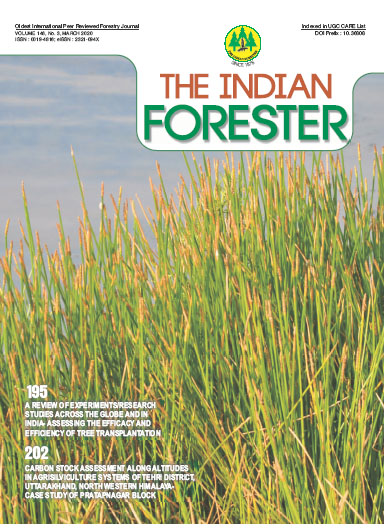Co-Occurrence of Leucanthemum vulgare and Lupinus polyphyllus in Gulmarg Region of Kashmir Valley will Accelerate the Depletion of Native Diversity?. Field Investigations are Need of the Hour
DOI:
https://doi.org/10.36808/if/2020/v146i3/147454Keywords:
Invasive species, invasion meltdown, NBAAbstract
No Abstract.References
Brandis D. (1882). The forests of South India. Indian Forester, 7: 363-369.
Dar G.H., Bhagat R.C. and Khan M.A. (2002). Biodiversity of the Kashmir Himalaya, alley Book House, Srinagar, India, 15.
David B. (2015). Preventing the spread of the invasive plant Lupinus poiyphuiius. www22.diva-portal.se/smash/get/diva2:893657/FULLTEXT01.pdf.
Dayal V. (2007). Social diversity and ecological complexity: how an invasive tree could affect diverse agents in the land of the tiger. Environ DevEcon, 12:1-19.
Elven R. and Fremstad E. (2000). Fremmede planter i Norge. Flerarige arter av slekten lupin Lupinus L. Blyttia, 58: 10-22.
Forero L.G., Nader A., Craigmill J.M., Ditomaso B., Puschner, and Maas J. (2011). Livestock-poisoning plants of California. Publication 8398. Agriculture and Natural Resources, Univ. of California.http://anrcatalog.ucdavis.edu/pdf/8398.pdf (accessed 26 May 2016).
Khuroo A.A., Rashid I., Reshi, Z., Dar G.H. and Wafai B.A. (2007). The alien flora of Kashmir Himalaya. Biological Invasions, 9: 269-292.
Khuroo A.A., Malik A.H., Reshl Z.A. and Dar G.H. (2010). From ornamental to detrimental: plant invasion of Leucanthemum vulgare Lam. (Ox-eye Daisy) in Kashmir valley, India. Current Science, 98 (5): 600-602.
Kumar S. (2001). Management of Lantana in India: trend, prospects and need for integrated approach. In: Proceedings Workshop on Alien Weeds in Moist Tropical Zones: Banes and Benefits. 91-106.
Ley E.L., Buchmann S McGuire K. and Holmes R. (2007). Selecting plants for pollinators: a regional guide forfarmers, land managers, and gardeners in the Pacific Lowland Mixed Forest Province. Pollinator Partnership and the North American PollinatorProtection Campaign, San Francisco http://pollinator.org/PDFs/Guides/PacificLowlandrx9 FINAL.pdf (accessed 26 May 2016).
Richardson D.M., Allsopp N.,'Antonio C.M.D, Milton S. J. and Rejmanek M. (2000). Plant invasions: The role of mutualisms. Biological Reviews, 75: 65-93.
Sandilyan S. (2015). Highways of India: A heaven to invasive alien plants. Science India, 18 (12): 33-36.
Sandilyan S. (2016). Occurrence of ornamental fishes: a looming dangerfor inland fish diversity of India. Current Science, 110 (11): 2099-2104.
Sandilyan S. and Charlotte I.E.A. van't Klooster. (2016). The other sides of invasive alien plants of IndiaWith special reference to medicinal values. Journal for Nature Conservation, 31: 16-21.
Sandilyan S., Meenakumari B. and Biju Kumar A. (2018). A review on Impacts of invasive alien species on Indian inland aquaticecosystems. National Biodiversity Authority, Chennai. 1-46.
Simberloff D. (2006). Invasional meltdown 6 years later: important phenomenon, unfortunate metaphor, or both? Ecol. Lett, 9: 912-919.
Tiwari JWK.(1999). Exotic weed Prosopis juliflora in Gujarat and Rajasthan, India: boon orbane? Tiger paper, 26:2125.
von der Lippe M., Bullock JM., Kowarik I., Knopp T.and Wichmann M. (2013). Human-mediated dispersal ofseeds by the airflow of vehicles. PLOS ONE, 8: e52733.
www.cbd.int/invasive/doc/cbd-patbf-brochure-en.pdf. Accessed on 17/6/16.
www.plants.usda.gov/plantguide/pdf/pg_lupo2.pdf. Accessed on 24/5/16.
Downloads
Downloads
Published
How to Cite
Issue
Section
License
Unless otherwise stated, copyright or similar rights in all materials presented on the site, including graphical images, are owned by Indian Forester.





